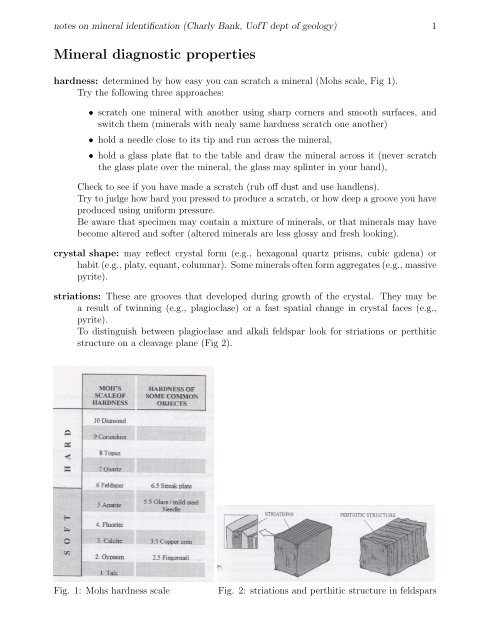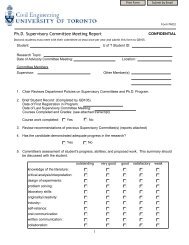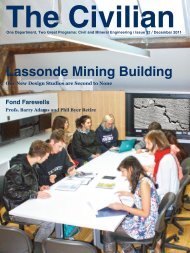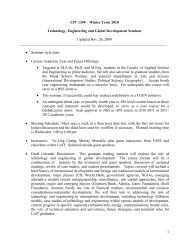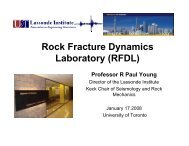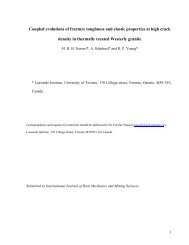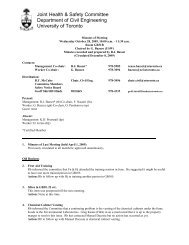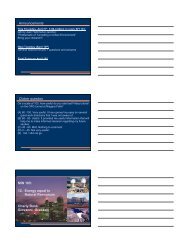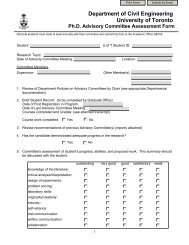Mineral diagnostic properties - Civil Engineering
Mineral diagnostic properties - Civil Engineering
Mineral diagnostic properties - Civil Engineering
You also want an ePaper? Increase the reach of your titles
YUMPU automatically turns print PDFs into web optimized ePapers that Google loves.
notes on mineral identification (Charly Bank, UofT dept of geology) 1<br />
<strong>Mineral</strong> <strong>diagnostic</strong> <strong>properties</strong><br />
hardness: determined by how easy you can scratch a mineral (Mohs scale, Fig 1).<br />
Try the following three approaches:<br />
• scratch one mineral with another using sharp corners and smooth surfaces, and<br />
switch them (minerals with nealy same hardness scratch one another)<br />
• hold a needle close to its tip and run across the mineral,<br />
• hold a glass plate flat to the table and draw the mineral across it (never scratch<br />
the glass plate over the mineral, the glass may splinter in your hand),<br />
Check to see if you have made a scratch (rub off dust and use handlens).<br />
Try to judge how hard you pressed to produce a scratch, or how deep a groove you have<br />
produced using uniform pressure.<br />
Be aware that specimen may contain a mixture of minerals, or that minerals may have<br />
become altered and softer (altered minerals are less glossy and fresh looking).<br />
crystal shape: may reflect crystal form (e.g., hexagonal quartz prisms, cubic galena) or<br />
habit (e.g., platy, equant, columnar). Some minerals often form aggregates (e.g., massive<br />
pyrite).<br />
striations: These are grooves that developed during growth of the crystal. They may be<br />
a result of twinning (e.g., plagioclase) or a fast spatial change in crystal faces (e.g.,<br />
pyrite).<br />
To distinguish between plagioclase and alkali feldspar look for striations or perthitic<br />
structure on a cleavage plane (Fig 2).<br />
Fig. 1: Mohs hardness scale<br />
Fig. 2: striations and perthitic structure in feldspars
notes on mineral identification (Charly Bank, UofT dept of geology) 2<br />
cleavage/fracture: some minerals split along smooth planes (cleavage), while others break<br />
along irregular surfaces (fracture). Cleavage is described by a number (1, 2, 3, 4, 6),<br />
an angle (larger - equal - smaller 90 ◦ ), and a quality (excellent, good, poor), see Fig 3.<br />
Cleavage is a very useful property (e.g., cubic cleavage in halite, rhombic cleavage in<br />
calcite). Cleavage is an easy way to distinguish between pyroxenes and amphiboles (2<br />
cleavages at 90 ◦ or 120 ◦ ). Fracture ranges in type and quality; two distinctive types are<br />
conchoidal (shell-shaped, like quartz) and hackly (like torn metal). To observe cleavage,<br />
turn the mineral until you see a flash of reflected light from the specimen (Fig 3).<br />
Fig 3: observation and description of cleavage<br />
colour/streak: Note that colour is <strong>diagnostic</strong> only for very few minerals. Streak is the colour<br />
of a mineral in powdered form, it tends to be more uniform (e.g., black streak of galena).<br />
lustre: defines how light is reflected and refracted by a mineral. Some terms to describe<br />
lustre (and examples) are:<br />
• metallic: bright (galena), dull (magnetite)<br />
• non-metallic: brilliant (diamond), glassy (quartz), greasy (massive serpentine),<br />
pearly (talc), silky (asbestos), dull (kaolinite)<br />
density: Opaque metallic minerals (like pyrite or galena) tend to be denser than non-metallic<br />
ones (like quartz or feldspar). Departures from this general rule may be <strong>diagnostic</strong> (e.g.,<br />
barite).<br />
tenacity: or how minerals break. Many minerals are brittle, that is they will break into<br />
powder (quartz, feldspar, halite). Elastic minerals will bend and spring back (e.g.,<br />
mica), while malleable can be hammered flat (e.g., copper).<br />
unusual <strong>properties</strong>: Halite (rock salt) tastes salty. Carbonate minerals will evernesc (fizz<br />
when acid is dropped on). Always handle acid carefully, and blot off with paper towel!<br />
A few minerals are magnetic (e.g., pyrrhotite vs. pyrite, magnetite vs. chromite).
notes on mineral identification (Charly Bank, UofT dept of geology) 3<br />
mineral H cl(eavage)/fr(acture) other <strong>properties</strong> uses<br />
talc Mg, (OH) sheet sil. 1 1 excellent cl pearly lustre; white, pale green, tan; soapy feel talcum powder<br />
graphite C 1 1 excellent cl metallic lustre; silvery gray to black, dark gray streak (writes lubricant, pencil lead<br />
on paper); very soft, greasy feel<br />
gypsum Ca[SO4] 2 1 good, 2 weak cl glassy to pearly crystals, pale colours plaster, dryboard<br />
galena P bS 2.5 3 perfect cl (cubes) bright silver to dull gray, black streak; very heavy! lead ore<br />
muscovite mica<br />
K, Al sheet silicate<br />
2.5 1 excellent cl colourless, pearly to glassy lustre; sheets elastic and flexible for electrical insulation<br />
biotite mica<br />
K, Mg, F e, Al sheet sil.<br />
2.5 1 excellent cl black to dark amber, pearly to glassy lustre; sheets elastic<br />
and flexible<br />
for electrical insulation<br />
halite Na[Cl] 2.5 3 good cl (cubes) pale colours, glassy to greasy lustre, salty taste table salt, de-icing<br />
calcite Ca[CO3] 3 3 exc. cl (rhombs) glassy, pearly lustre, variable colours; reacts with acid calcium supplement<br />
barite Ba[SO4] 3-3.5 1 perfect cl, 2 good colorless to white; short tabular crystals; very heavy rubber, paint, glass<br />
chalcopyrite CuF e[S]2 3.5-4 2 poor cl metallic lustre; golden or brassy yellow color, tarnishes<br />
brown or iridiscent<br />
copper ore<br />
sphalerite ZnS 3.5-4 6 exc. cl (dodec.) sub- to non-metallic lustre; usually yellow-brown to black zinc ore<br />
fluorite Ca[F ]2 4 4 exc. cl (octahed.) transparent; colourless, purple, green, yellow; often cubes source of fluorine<br />
apatite Ca5F [P O4]3 5 conchoidal fr pale to dark green, blue, white; hexagonal prisms fertilizer<br />
hematite F e2[O]3 5-6 uneven fr metallic lustre; silvery gray, black, or brick red, red-brown pigment, iron ore<br />
streak; often massive<br />
magnetite F eF e2[O]4 5.5 uneven fr bright-dull metallic; black streak; magnetic; octahedrons iron ore<br />
pyrite F eS2 5.5-6 conchoidal to uneven<br />
fr<br />
brassy yellow, may tarnish iridescent; greenish-brownishblack<br />
streak; commonly found as cubes or pyritohedrons<br />
K-feldspar K[AlSi3O8] 6 2 exc. cl at 89 ◦ glassy to pearly (alters to dull and softer); variable colour<br />
(often pink); may show perthitic structure<br />
plagioclase feldspar<br />
(Na, Ca)[AlSi3O8]<br />
amphibole group<br />
double-chain sil.<br />
pyroxene group<br />
single-chain sil.<br />
6 2 exc. cl at 87 ◦ glassy to pearly (alters to dull and softer); variable colour,<br />
pale (Na-rich) to dark (Ca-rich); (twinning) striations on<br />
one cleavage face; may show iridescence<br />
6 2 good cl at 124 ◦ glassy (alters to dull and softer); variable colour: white to<br />
dark greenish-black; hornblende has gray/green streak<br />
6 2 fair cl at 87 ◦ glassy (alters to dull and softer); variable colour: pale to<br />
green-black; augite: gray/green streak<br />
ore mineral<br />
glass, ceramics; very<br />
common in rocks<br />
glass, ceramics; very<br />
common in rocks<br />
rock-forming min<br />
rock-forming min<br />
garnet group inosilicate 7 conchoidal fr glassy; many colours (often red); dodecahedral crystals sandpaper, gemstone<br />
quartz SiO2 7 conchoidal fr glassy; clear, variable col.; sometimes 6-sided crystals glass


